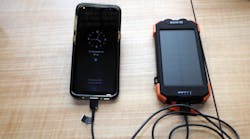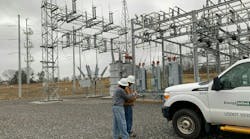Happy New Year everyone! The past year brought about a lot of advancements with digital technologies throughout the power grid. Just for the heck of it, I went back over the topics that were covered in the 2021 “Charging Ahead.” Some of the more interesting applications were related to making renewable energy more grid friendly, dependable with less stability issues. Also, IoT (internet of things) technologies found their way into the grid big time.
They are being adapted to make personnel safer (smart hardhats), better remote workplace equipment, and turning the office into a touchless environment. I can’t wait to see what’s next. That’s why I get such a kick out of the November and December technology unveilings. I look for what is going to be the most popular tech toy and is it adaptable to the power grid?
Tech Toys
This year Santa brought me a portable solar power bank. It’s a small photovoltaic (PV) panel assembly with energy storage built in. According to Santa, they were in high demand and were flying off the shelves. I have been wanting to explore solar plus technology and the solar power bank fit the order. It has a polymer lithium battery with a 10,000mAh (milli amp hour) rating and a complete range of USB output plugs.
I put the power bank in my office window and the desert sun quickly recharges my e-reader, tablet, and smartphone. It even has the capability to recharge my smart phone inductively. As a utility engineer I have been in some really remote areas and a PV power bank would have been a welcomed accessory especially when heavy use depleted the smartphone’s battery.
Speaking of smartphones, they are leading the tech toy pack, but that is to be expected. This year’s offerings are full of improvements with ruggedization being very popular. Have you heard of NEMA’s IP (Ingress Protection) rating for devices? The IP rating refers to how effective a device is at blocking foreign bodies (i.e., dust, liquids, etc.), and it’s important in ruggedizing.
In the world of smartphones, every smartphone is considered water-resistant, but that’s not waterproof, and there is a difference. Also, there are lots of caveats when it comes to defining water-resistance. Some phones can be dropped in a puddle for a few seconds, while others can take submergence in several feet of water for up to 30 minutes. If you’re in the field a lot, look for an IP67 or IP68 or higher, and you will not have to worry about a rainy day or a slip into the water. By the way, tables have IP ratings too, and it pays to check them out.
Mirror, Mirror on the Wall
Looking back at grid adaptable consumer technologies; a few months ago “Charging Ahead” featured a story about redefining remoteness. Virtual and augmented reality technologies are changing how workers define remote. The discussion focused on the remote facilities, but what about the offsite workers?
Well, this season’s consumer electronics had something with the potential of addressing the decentralized workplace too. It’s a very large mirror or so it seemed. There was a photo of a person standing in front of a full length mirror. What does a mirror have to do with digital technology? It turns out this mirror is actually a highly sophisticated digital device. When the technology is deenergized, you see a mirror, which blends into the room’s decor.
Energize the app, and the mirror converts a portal to a yoga studio, a workout gym, a HIIT (high-intensity interval training) class, etc. Thinking about it, it wouldn’t be that hard to modify this device to become a portal to a virtual power grid environment. It takes the IT/OT (information technology/operational technology) convergence to a different level. Imagine a scattered project team joining together via the augmented reality portal to visit a facility.
It looks like 2022 is going to be more growth in IoT technology adapted to the smart grid. Several research reports are very positive on that growth. Estimates place the 2021 smart grid technology expenditures around US$ 43 billion. It’s expected this will grow to about US$ 103 billion by 2026. These consumer electronics adaptations may not be big ticket items, but these IoT technologies have a lot going for them. A major plus is safer working conditions for personnel. With applications like these, I expect 2022 to be an exciting year when it comes to technologies!


